Dimpled Chads Under The Microscope
By Peter K. Sheerin
In order to put the Florida recount controversy in better focus, I had the office of a government official take a few sample Votomatic punch card ballots and perform some of the experiments that Bill Wattenburg suggested in this article. This material should be of keen interest to anyone involved in election procedures or the ongoing recounts down in Florida.
This page was updated on December 26th to reflect my tests on actual punch-card voting machines, rather than the original tests, which were based on already-punched cards supplied to me by a government office. I now have both a Votomatic and a Pollstar machine, and six different styluses that have been used at various times and in various places. Looking at the equipment I now have, it appears that the ballots I first posted pictures of were made on a Pollstar machine, which functions identically to the Votomatic but has a different case and slightly different stylus design. Please read all of the details below to make sure you understand the whole story.
 To capture
these images I used a microscope hooked up to my computer (a
nifty USB device from Intel and Mattel called the Intel Play QX3
Microscope—about $99 at better toy stores or directly
at www.IntelPlay.com) at a magnification of
10× and 60×. If you’ve got a curious kid (or one that you’d
like to be) this would make a great holiday gift. Oh, and though I’m the
technical editor for a computer magazine and can easily get access to this and
much more expensive gadgets, I buy my own toys, thank you very much (I bought
mine on sale at Zany Brainy for $70).
To capture
these images I used a microscope hooked up to my computer (a
nifty USB device from Intel and Mattel called the Intel Play QX3
Microscope—about $99 at better toy stores or directly
at www.IntelPlay.com) at a magnification of
10× and 60×. If you’ve got a curious kid (or one that you’d
like to be) this would make a great holiday gift. Oh, and though I’m the
technical editor for a computer magazine and can easily get access to this and
much more expensive gadgets, I buy my own toys, thank you very much (I bought
mine on sale at Zany Brainy for $70).
Note that some of the little details don’t show up very well in a straight-on shot produced with the microscope, but they show up very well when lit and viewed from an angle. The built-in lights on the microscope were not always useful, so for some of the shots I turned them off and used an LED flashlight to create enough shadows to identify the features.
The photography and commentary below is entirely mine, but I owe many thanks to the friend (who shall remain nameless) in an official government office who was able to provide me with the demonstrator ballots, punched on a genuine machine. When you finish with this article, please go read Dr. Bill Wattenburg’s article detailing how to do these experiments, as well as how to test a Votomatic machine to see if it can actually be plugged up to the point that it will prevent chads from being detached from the card. You might also be interested in reading a few comments provided by John Ahmann, one of the engineers involved with the Votomatic machine over the past 35 years.
What is a Votomatic?
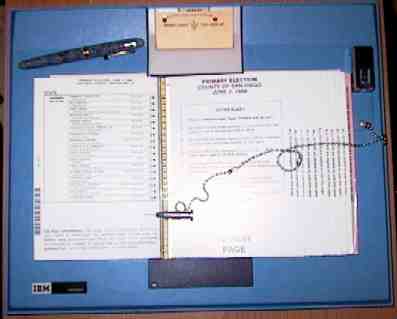 The Votomatic machine
(shown at left) was created by IBM back in the early sixties, and was
later sold off to a separate company (run by ex-IBM employees).
The Votomatic machine
(shown at left) was created by IBM back in the early sixties, and was
later sold off to a separate company (run by ex-IBM employees).
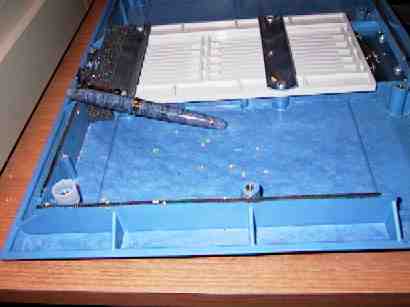 To
address the claims some have made that the Votomatic machines can plug up, here
is a picture of the inside of the machine (the pen is included for reference).
At least one estimate I am familiar with indicates that this model will hold
well over a million chad. And one experiment related to me second-hand was to
remove the back of the unit (as shown here), fill it so full of chad that it was
difficult to put the cover back on, and then trying to punch out the chad as one
would in normal voting. The reported result was that it seemed to be just as
easy to punch, and no dimples were created.
To
address the claims some have made that the Votomatic machines can plug up, here
is a picture of the inside of the machine (the pen is included for reference).
At least one estimate I am familiar with indicates that this model will hold
well over a million chad. And one experiment related to me second-hand was to
remove the back of the unit (as shown here), fill it so full of chad that it was
difficult to put the cover back on, and then trying to punch out the chad as one
would in normal voting. The reported result was that it seemed to be just as
easy to punch, and no dimples were created.
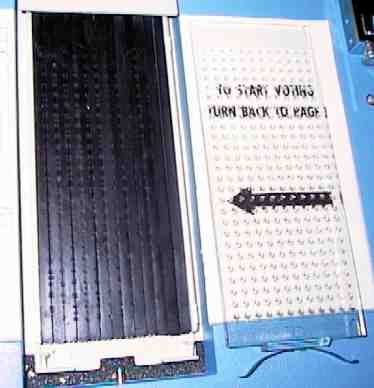 There
have also been claims that the rubber T-strips (shown at left, with the plastic
template at the right side of the picture) can harden and wear-out and must
be replaced occasionally. The Votomatic machine I have is a 35-year-old unit,
and the condition of the rubber seems to bear lots of use. Most of the wear that
is visible consists of gray, rectangular marks straddling each slot. But there
are also a few holes through the strips, which must have been made by repeated
off-center punch of the stylus. I found that even these holes had no impact on
my ability to completely punch out chad, since the holes are much smaller than
the chad itself. If anything, these holes only make it easier to vote in those
locations, and although I have not noticed any creation of hanging chad in these
cases, John Ahmann (a former IBM engineer who was involved with the election
machines for 35 years, and who testified in the weekend-long Florida trial about
the recounts) says that this can be a problem. As to the concerns of the rubber
hardening with age, John Ahmann has also stated that the rubber used was a
combination of natural rubber (which tends to harden with age) and synthetic
rubber (which tends to soften with age), so that the net effect is very low.
(John claims the hardening is about 5% over 35 years, which is very slightly
higher than the original manufacturing tolerance. From visual inspection, it
appears that the Pollstar rubber T-strips are thinner than the Votomatic strips,
which, given the same composition, would produce somewhat less resistance when
voting.
There
have also been claims that the rubber T-strips (shown at left, with the plastic
template at the right side of the picture) can harden and wear-out and must
be replaced occasionally. The Votomatic machine I have is a 35-year-old unit,
and the condition of the rubber seems to bear lots of use. Most of the wear that
is visible consists of gray, rectangular marks straddling each slot. But there
are also a few holes through the strips, which must have been made by repeated
off-center punch of the stylus. I found that even these holes had no impact on
my ability to completely punch out chad, since the holes are much smaller than
the chad itself. If anything, these holes only make it easier to vote in those
locations, and although I have not noticed any creation of hanging chad in these
cases, John Ahmann (a former IBM engineer who was involved with the election
machines for 35 years, and who testified in the weekend-long Florida trial about
the recounts) says that this can be a problem. As to the concerns of the rubber
hardening with age, John Ahmann has also stated that the rubber used was a
combination of natural rubber (which tends to harden with age) and synthetic
rubber (which tends to soften with age), so that the net effect is very low.
(John claims the hardening is about 5% over 35 years, which is very slightly
higher than the original manufacturing tolerance. From visual inspection, it
appears that the Pollstar rubber T-strips are thinner than the Votomatic strips,
which, given the same composition, would produce somewhat less resistance when
voting.
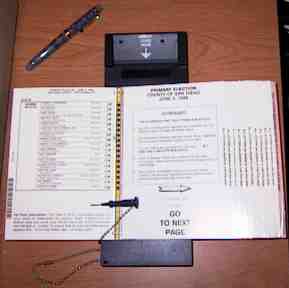 Years later another
company created its own, compatible version, called the Pollstar. Both use the
same ballots (80-column IBM punch cards with a fraction of the possible
locations in the 12-by-80 matrix used (typically a third, with the remainder
used to ensure comfortable separation and to provide space to label each
location with a number. The most common ballot has just 312 of the possible 960
locations pre-perforated as “chad”, though some forms have fewer or
more used, for reasons ranging from limitations of early counting machines to
counties with a large number of candidates and issues on the ballot.
Years later another
company created its own, compatible version, called the Pollstar. Both use the
same ballots (80-column IBM punch cards with a fraction of the possible
locations in the 12-by-80 matrix used (typically a third, with the remainder
used to ensure comfortable separation and to provide space to label each
location with a number. The most common ballot has just 312 of the possible 960
locations pre-perforated as “chad”, though some forms have fewer or
more used, for reasons ranging from limitations of early counting machines to
counties with a large number of candidates and issues on the ballot.
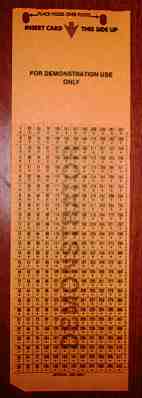 A punch-card ballot
(shown at left) is inserted into the top of the machine and aligned on a
set of pegs that are meant to insure proper alignment of the ballot with the
template, the slate holder, and the rubber strips that catch the chad. Once this
is done the voter turns to the first page on the ballot and uses the stylus to
punch through the hole next to the desired candidate or issue, repeating with
each page until the whole ballot has been completed (if the voter wishes to vote
for every office and/or issue). The ballot is then removed from the machine and
dropped in the appropriate box. In some counties, each precinct has a vote
counting machine, in which case the voter can have the ballot read before
leaving the polling place. This allows the voter to determine if their ballot
has been cast and read properly—if they choose.
A punch-card ballot
(shown at left) is inserted into the top of the machine and aligned on a
set of pegs that are meant to insure proper alignment of the ballot with the
template, the slate holder, and the rubber strips that catch the chad. Once this
is done the voter turns to the first page on the ballot and uses the stylus to
punch through the hole next to the desired candidate or issue, repeating with
each page until the whole ballot has been completed (if the voter wishes to vote
for every office and/or issue). The ballot is then removed from the machine and
dropped in the appropriate box. In some counties, each precinct has a vote
counting machine, in which case the voter can have the ballot read before
leaving the polling place. This allows the voter to determine if their ballot
has been cast and read properly—if they choose.
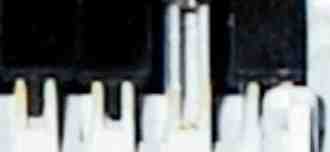 The rubber
that is used to help detach the chads is a set of strips, shaped
like a capital “T” mounted in the machine with the top of the
“T” facing up and abutting the top of each adjacent “T”
strip. This provides resistance at the edges of the chads while the stylus is
pushed through between the strips. The support provided at the edges of the chad
not only aids in their detachment, it provides enough resistance to make the
dimple made by a stylus very distinct from a dimple made with any other
improvised device, or even the mark made by a real stylus on a ballot that is
not in a voting machine. If one is intent on counting hanging chad, it is
imperative that observations be made to ensure that the intent of the voter can
be accurately determined, and fraudulent changes made after voting can be
caught.
The rubber
that is used to help detach the chads is a set of strips, shaped
like a capital “T” mounted in the machine with the top of the
“T” facing up and abutting the top of each adjacent “T”
strip. This provides resistance at the edges of the chads while the stylus is
pushed through between the strips. The support provided at the edges of the chad
not only aids in their detachment, it provides enough resistance to make the
dimple made by a stylus very distinct from a dimple made with any other
improvised device, or even the mark made by a real stylus on a ballot that is
not in a voting machine. If one is intent on counting hanging chad, it is
imperative that observations be made to ensure that the intent of the voter can
be accurately determined, and fraudulent changes made after voting can be
caught.
Thus far I have only been able to obtain so-called “demonstrator” ballots. These are of the same cardstock, size, and layout as the actual ballots, but are imprinted with the word “DEMONSTRATOR” to make it clear they must not be counted during an actual election. Due to the appropriately strict rules for manufacturing and handling ballots, I have found it impossible to obtain “real” ballots, and some people have cautioned me that these demonstrator ballots are often cut using worn-out dies (the metal parts that make the perforations forming each chad) and are likely to be out of spec, thus causing the chads to be more difficult to punch out. A quick and dirty test with a postal scale indicates that the “demonstrator” ballots I have appear to be within the specification limit, but I will have to redo those tests with better equipment before stating that case without doubt. And if you wish to perform these tests yourself, please make sure that the ballots you are using adhere to the specifications (between 150 and 350 grams of force required to dislodge a chad).
The Stylus
With the first pictures I posted here I initially stated that the dimpled chad was made on a Votomatic machine. But having examined the actual equipment, I now believe they were made on a Pollstar machine, because it has a unique “pinpoint stylus” that leaves the distinctive pinprick and crease that I describe. Because the Pollstar is exactly the same as the Votomatic in operation and both machines use interchangeable parts (the stylus, the slate holder, and the plastic template), I’m not surprised of the misunderstanding I had with my original source. I must stress that the only difference apparent when looking at the chad is the pinprick—and keep in mind that it’s always possible that some counties and/or precincts use the Pollstar stylus with the Votomatic machine, or that there is yet another stylus design used with the Votomatic that I have not yet seen.
From left to right in the picture below are two older style styli with metal bodies (the first has a flared tip), two newer style styli with flexible rubber bodies (the second has a slight pinpoint tip), next is the Pollstar stylus (with a pronounced pinpoint tip), and last is a typical stylus provided with absentee ballots (it looks like half of a paperclip, but is much stiffer).
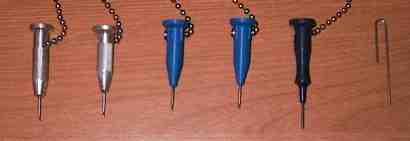
(The pictures below are taken at 10× and 60×)
Below is an older design, metal-bodied stylus used on the Votomatic machine (there is a variant with a slightly broader, flared tip, second from the left in the above picture). The ridges near the tip are designed to help ensure that the chad is fully detached and pushed through the rubber strips.
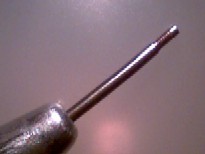
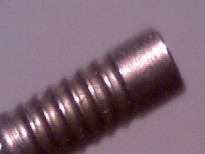
This is a late-model Votomatic stylus. Note that its body is a flexible plastic, and it has a small pinpoint on the tip (the one I have appears to be worn, but I believe most of these styluses will show a more pronounced point).
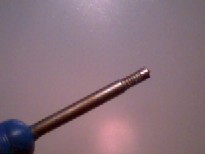
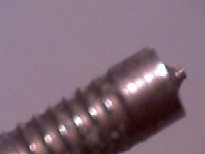
This is the Pollstar stylus. Notice the absence of ridges, and the conspicuous “pinpoint tip”.
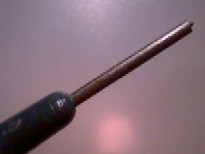
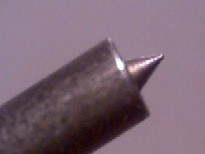
Real Dimpled Chad
(But probably not real votes)
The images below shows dimpled chads created with real styluses in the Pollstar and Votomatic machines. Note that all have a clear stylus mark on them—the circular depression (the Pollstar ones also have a pinprick and a crease).
But let’s say—just for the sake of the argument—that the claims about the machines getting “plugged up” are true, and the so-called “dimpled chads” are actually real votes. These would have to have most or all of the characteristics of the “real chads” described here (including a very noticeable imprint of the stylus itself, because of the pressure against the stack of chads), and likely be more bowed in than is evident in the first picture below because of the pressure of the top chad being pressed against the plugged-up stack (these dimples were made with very light pressure).
Votomatic Hanging Chad
These pictures show what was at first “hanging” chad, made on a Votomatic machine with the metal-bodied stylus (the one without the pinpoint tip)—I then carefully plucked them off the ballot with a strawberry huller, carefully avoiding making any additional marks. The third picture is a 60× close-up of one of the chads. All of these were created by purposely misaligning the ballot in the machine so that I could punch on the edge of the chad. This is the only way I have yet devised to create hanging chad. All other attempts have created either dimples or clean punches that completely detached the chad.
It should be noted that some of my attempts to create dimples (by intentionally avoiding pushing the stylus all the way through the machine) have almost completely detached the chad that, while it appeared to be held in place, could easily fall out completely or be left hanging by only one or two corners, and be subject to further detachment if the ballot were handled enough (or perhaps by the mere act of being put through an automated counting machine). It is entirely possible that some of the “overvotes” (where someone supposedly punched two candidates for President) were a result of this. A likely explanation for this case is someone starting to punch one candidate (thus creating a dimpled chad), then changing his or her mind and fully punching another candidate. Should that dimpled chad be disturbed enough, it could fall off entirely or be pushed aside far enough to let sufficient light to pass through the hole to trigger the counting machine’s sensors.
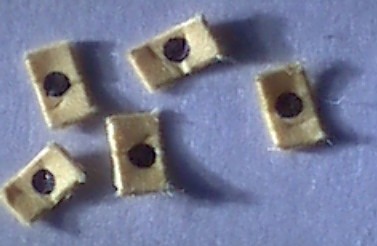
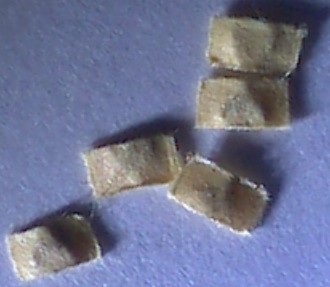
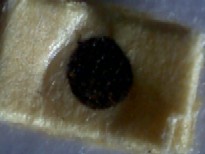
Pollstar Dimpled Chad
There are three key characteristics that can be used to identify real dimples from fake ones in a Pollstar machine:
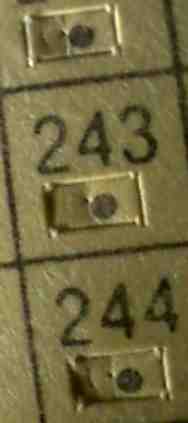
- A real Pollstar dimple will always have a pinprick, and it will be at the center of any circular depression.
- If the stylus was pressed with anything more than very light pressure, A circular or semi-circular depression will be visible.
- Because the pin-like tip of the stylus hits the paper before the rod part of the tip, a linear crease will almost always be formed. Notice that this crease is much sharper than that created by an improvised stylus without a pin-like center (see photos below). If made with anything more than light pressure, the pinprick will create a hole large enough to let light through (when viewed on a microscope at sufficient enough magnification).
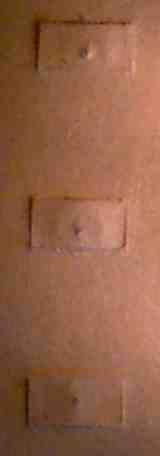
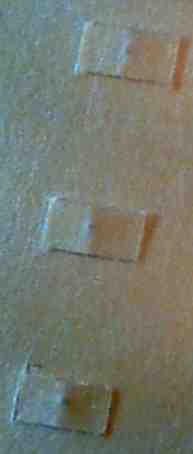 In
fact, while the microscope used with side lighting clearly shows the detail of
the dimples, the two key elements—the pin-prick and the vertical crease—can
be seen by the naked eye if you look at the reverse side of the ballot.
In
fact, while the microscope used with side lighting clearly shows the detail of
the dimples, the two key elements—the pin-prick and the vertical crease—can
be seen by the naked eye if you look at the reverse side of the ballot.
Out of more than a dozen dimples on one card, the two on the top of the left
image were the only ones that didn’t display a clear crease, but they do clearly
show both the pinprick and the circular edge of the stylus.
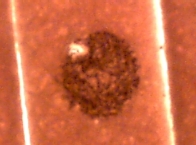 This
is an example of what a backlit pinprick looks like under the microscope. The
location of the pinprick will vary, but will always be close to the center of
the chad, roughly in the middle third of the chad.
This
is an example of what a backlit pinprick looks like under the microscope. The
location of the pinprick will vary, but will always be close to the center of
the chad, roughly in the middle third of the chad.
Punched Chad
If the machine or ballot is far enough out of alignment, it is possible to create a different mark on the card—one in which the dimple straddles the edge of the chad (if the voter doesn't push the stylus all the way through) or in which the stylus is punched all the way through, bending and tearing both the chad and the adjacent edge of the ballot. In the picture below, chad no. 88 has been dimpled purposely (this would not be a correctly-executed vote) while numbers 89 and 90 have been punched completely through. Note the differences between these three, especially the visibly torn nature of the ballot itself in 89 and 90. A closer inspection than 10x may be necessary to tell the difference in these cases.
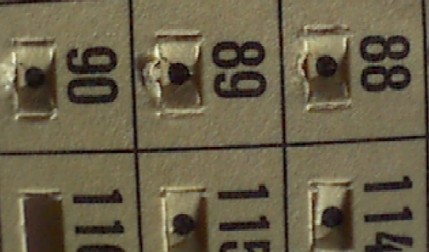
Fake Dimpled Chad
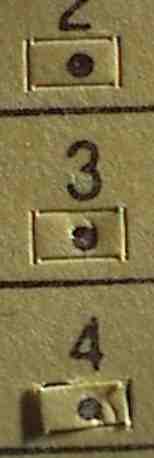 This
set of dimpled chads was created by that same Votomatic stylus, but with
the card on the hard surface of a table instead of in the machine. Notice that
while the pinprick, and sometimes the semi-circular edge, of the stylus is
visible, there is no indication of the vertical crease created when the card is
actually in the machine.
This
set of dimpled chads was created by that same Votomatic stylus, but with
the card on the hard surface of a table instead of in the machine. Notice that
while the pinprick, and sometimes the semi-circular edge, of the stylus is
visible, there is no indication of the vertical crease created when the card is
actually in the machine.
I had the above ballots sent to me, along with some unused ones, and then created some dimples of my own, using my fingernail (cut down to produce my own, organic “stylus”), and also with a plastic PDA stylus (the pen-like device used to write on a Palm Pilot, if you don’t know what a PDA is).

 The dimpled chads
created with my fingernail (not shown; there was no noticeable crease or other
mark) don’t exhibit the vertical crease created by the real
stylus. And although the PDA stylus did create a crease (chads at left, both
front and back images), there is no pinprick in the chad as the real stylus would have created, nor is the crease a
clearly defined vertical mark, and there is a complete absence of any circular
mark that a real stylus would most likely have created.
The dimpled chads
created with my fingernail (not shown; there was no noticeable crease or other
mark) don’t exhibit the vertical crease created by the real
stylus. And although the PDA stylus did create a crease (chads at left, both
front and back images), there is no pinprick in the chad as the real stylus would have created, nor is the crease a
clearly defined vertical mark, and there is a complete absence of any circular
mark that a real stylus would most likely have created.
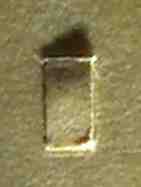 I
also took a stack of five punch cards and used my PDA stylus to punch
several of the chads. With firm pressure of the stylus it was very easy to punch
out all five chads (leaving most of them hanging), but with just moderate
pressure all five were created as dimpled chads. All of these chads lacked
the pinprick and after the second chad all
lacked any crease at all. If this is what is meant by a
“pregnant”
chad, than any such chad on a ballot is quite clearly not a vote of any
kind, shape, or form.
I
also took a stack of five punch cards and used my PDA stylus to punch
several of the chads. With firm pressure of the stylus it was very easy to punch
out all five chads (leaving most of them hanging), but with just moderate
pressure all five were created as dimpled chads. All of these chads lacked
the pinprick and after the second chad all
lacked any crease at all. If this is what is meant by a
“pregnant”
chad, than any such chad on a ballot is quite clearly not a vote of any
kind, shape, or form.
Voter Intent
My conclusion, based on these limited tests, is that any chad (hanging or otherwise) that is missing both the pinprick and the vertical crease is likely a fraudulent vote, or quite possibly an indication that the voter started to vote, but had a second thought and decided not to vote for any presidential candidate, as a small percentage of people in all presidential elections do.
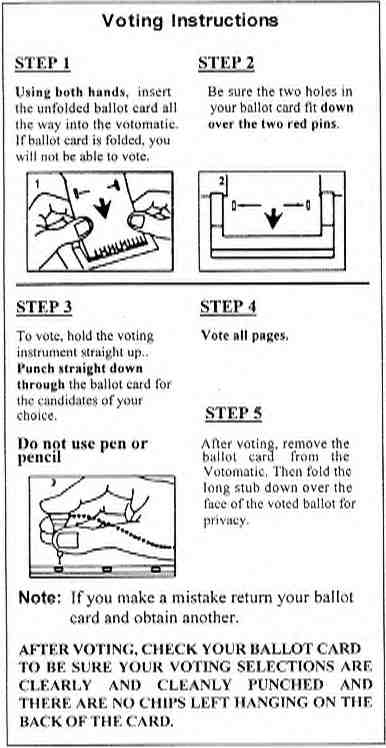 And just why did
anyone suggest in the first place that any dimple or hanging chad should count
as a vote in the first place? The instructions provided to voters using the
Votomatic describe the process of voting properly quite clearly (as shown at
left) and ends with a big, bold sentence admonishing the voter to make sure that
all of his or her votes are clear and no “hanging chips” are left.
And just why did
anyone suggest in the first place that any dimple or hanging chad should count
as a vote in the first place? The instructions provided to voters using the
Votomatic describe the process of voting properly quite clearly (as shown at
left) and ends with a big, bold sentence admonishing the voter to make sure that
all of his or her votes are clear and no “hanging chips” are left.
This page was last modified on .
Related Information |